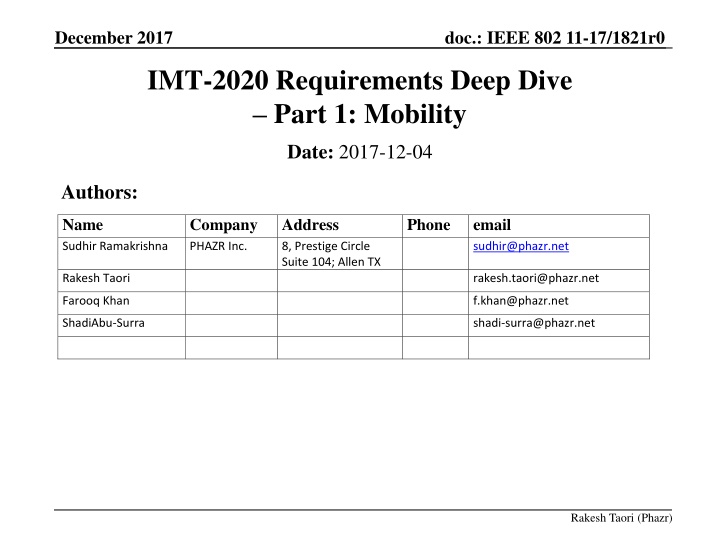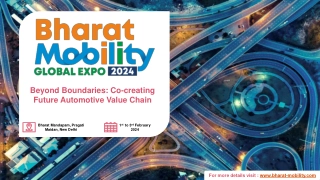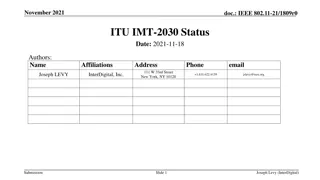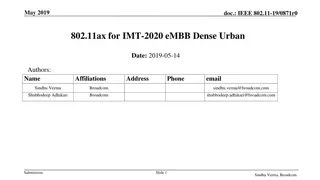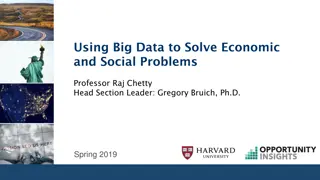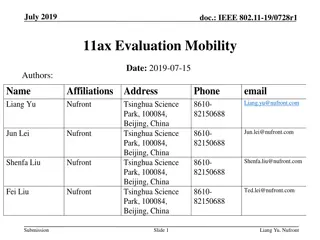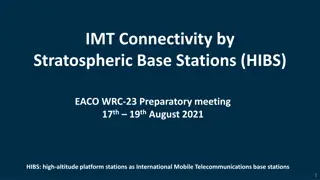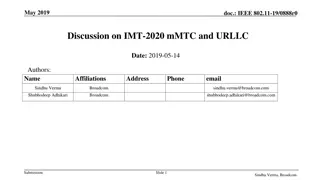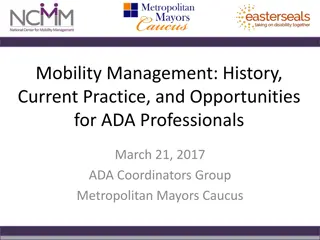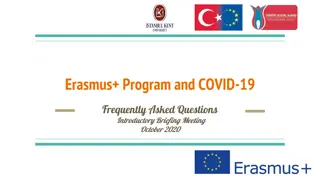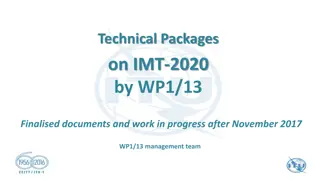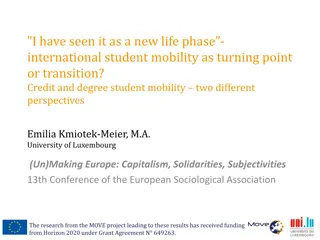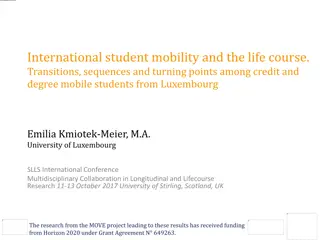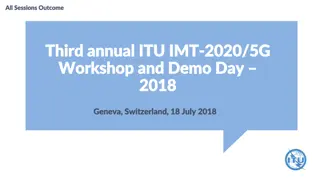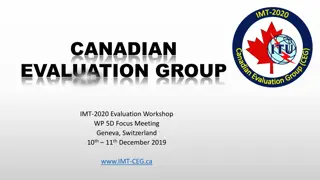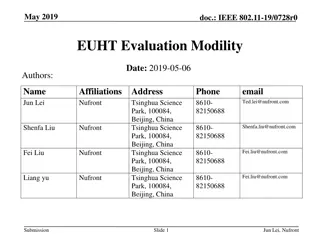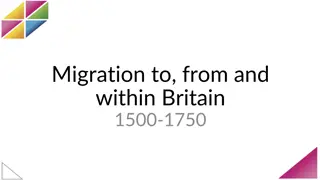IMT-2020 Mobility Requirements Deep Dive Part 1
This document delves into the intricate mobility requirements of IMT-2020, focusing on rural eMBB configurations and connection densities. It explores specific details such as antenna elements per TRx, spectral efficiency, and reliability. The content includes tables for eMBB urban, indoor hotspot, and rural scenarios, as well as an analysis of initial mobility effects on 802.11ac waveform performance.
Download Presentation

Please find below an Image/Link to download the presentation.
The content on the website is provided AS IS for your information and personal use only. It may not be sold, licensed, or shared on other websites without obtaining consent from the author.If you encounter any issues during the download, it is possible that the publisher has removed the file from their server.
You are allowed to download the files provided on this website for personal or commercial use, subject to the condition that they are used lawfully. All files are the property of their respective owners.
The content on the website is provided AS IS for your information and personal use only. It may not be sold, licensed, or shared on other websites without obtaining consent from the author.
E N D
Presentation Transcript
December 2017 doc.: IEEE 802 11-17/1821r0 IMT-2020 Requirements Deep Dive Part 1: Mobility Date: 2017-12-04 Authors: Name Company Address Phone email Sudhir Ramakrishna PHAZR Inc. 8, Prestige Circle Suite 104; Allen TX sudhir@phazr.net Rakesh Taori rakesh.taori@phazr.net Farooq Khan f.khan@phazr.net ShadiAbu-Surra shadi-surra@phazr.net Rakesh Taori (Phazr)
December 2017 doc.: IEEE 802 11-17/1821r0 Clustering the seemingly challenging requirements of IMT-2020 Mobility Requirements (especially for Rural eMBB) 4 GHz configuration: 3 km/h (indoor), 120 km/h (in-car) and 500 km/h (high-speed) Low mobility, large cell environment configuration : 3 km/h (indoor and pedestrian), 30 km/h (in-car) tested at 700 MHz Range Requirements (especially for Rural eMBB) 1732 m for sub-6 GHz (viz. 700 MHz and 4 GHz) 6000 m for 700 MHz Number of antenna elements per TRxP 64 Tx/Rx elements for frequencies 1 GHz (viz. 700 MHz) 256 Tx/Rx elements for frequencies above 1 GHz (viz. 4, 30, 70 GHz) Spectral efficiency Connection density Reliability Focus of this presentation Rakesh Taori (Phazr)
December 2017 doc.: IEEE 802 11-17/1821r0 IMT-2020 Mobility Requirements for eMBB Table 2: eMBB Urban Table 1: eMBB Indoor Hotspot Table 3: eMBB Rural Note: Spectral Efficiency Req. Rakesh Taori (Phazr)
December 2017 doc.: IEEE 802 11-17/1821r0 Initial Mobility Effect Analysis - Motivation Develop intuition on Doppler effects on performance of 802.11ac waveform w.r.t channel models in ITU-R.M2134 [1] Focus on the OFDM-modulated VHT payload portion of 802.11ac packet Provide impetus for further and more detailed studies by 802.11 members Rakesh Taori (Phazr)
December 2017 doc.: IEEE 802 11-17/1821r0 Initial Mobility Effect Analysis Methodology, 1/2 OFDM: ? ? = ? ? . ?=0 y(u)/x(u): Rx/Tx samples on sub-carrier #u hm: Accumulated time-domain channel tap amplitudes over sampling interval m ? 1 ?exp( ?2.?.? ?) For Doppler effect studies, sufficient to consider single sub-carrier Consider sub-carrier u = 0 Frequency domain channel coefficient, ? = ?=0 Frequency domain channel coefficient determinant of performance Time variation of C provides intuition into effects of Doppler on performance ? 1 ? Rakesh Taori (Phazr)
December 2017 doc.: IEEE 802 11-17/1821r0 Initial Mobility Effect Analysis Methodology, 2/2 Rakesh Taori (Phazr)
December 2017 doc.: IEEE 802 11-17/1821r0 Results, 1/2 TDL-iv TDL-i LoS + NLoS 1 Rician (K ~ 13 dB) + Rayleigh taps NLoS-only Rayleigh taps 700 MHz 4 GHz Rakesh Taori (Phazr)
December 2017 doc.: IEEE 802 11-17/1821r0 Results, 2/2 TDL-i TDL-iv NLoS-only Rayleigh taps LoS + NLoS 1 Rician (K ~ 13 dB) + Rayleigh taps 30 GHz Rakesh Taori (Phazr)
December 2017 doc.: IEEE 802 11-17/1821r0 Summary Preliminary analyses and results on the effect of Doppler w.r.t IMT-2020 eMBB scenarios were presented 802.11 members are encouraged to build upon these to generate more comprehensive analyses for submission to the IMT-2020 process R. Taori (Phazr), F. Khan (Phazr) et. al.
December 2017 doc.: IEEE 802 11-17/1821r0 References [1] Report ITU-R.2142, Guidelines for evaluation of radio interface technologies for IMT-2020 , @ https://www.itu.int/md/R15-SG05-C- 0057/en R. Taori (Phazr), F. Khan (Phazr) et. al.
December 2017 doc.: IEEE 802 11-17/1821r0 APPENDIX Rakesh Taori (Phazr)
December 2017 doc.: IEEE 802 11-17/1821r0 802.11 Waveforms vs. 5G Waveforms Rakesh Taori (Phazr)
